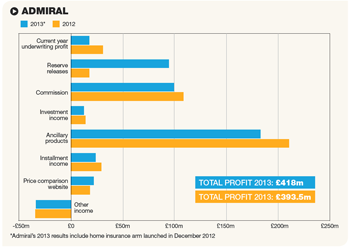Personal lines insurer’s COR improves by 3.1 points to 89.7%
Esure made a profit after tax of £93.2m in 2013, up 5.8% on the £88.1m it made in 2012.
Profit before tax was up 2.5% to £118.4m (2012: £115.5m).
The personal lines insurer’s combined operating ratio (COR) improved by 3.1 percentage points to 89.7% (2012: 92.8%).
The improved underwriting performance was in part thanks to a 20% increase in reserve releases to £82.4m (2012: £68.9m), of which £71.3m came from esure’s motor business and £11.1m from its home account.
As well as improving profitability, esure was able to grow. Gross written premium increased 4% to £535.8m (2012: £515m) and the number of in-force policies rose 9.9% to 1.933 million (2012: 1.759 million).
Esure chairman Peter Wood said: “Our financial performance in our first year as a listed company is a testament to the group’s resilience, adaptability and the quality of the management team.
“We held firm to disciplined underwriting throughout the year and capitalised on some market opportunities.”
Esure chief executive Stuart Vann added: “2013 was a year of strong, resilient financial performance within tough market conditions. The group has delivered premiums, customer numbers and earnings per share that are all up on the prior year.
“This performance has been underpinned by our disciplined underwriting, reserve strength and efficient expense base.
“The group is financially strong and continues to hold robust reserves in excess of 15% above the actuarial best estimate. We believe this prudent approach can be a significant differentiator over time given the prevailing market conditions.”
Motor performance
Esure boosted its motor underwriting profit by 34.4% to £41m (2012: £30.5m). The motor COR improved by 2.5 percentage points to 89.9% (2012: 92.4%).
The company said its motor book benefited from two opportunities in the year: the first full-year of gender-neutral pricing and re-entry into certain segments of the motor market that the company withdrew from four years ago because of the large number of whiplash claims.
However, these segments now command higher prices, the company has improved its underwriting and claims systems, and the Laspo reforms have come into force.
Vann said: “I believe these factors presented and continue to present a unique opportunity given our prior withdrawal. In advance of the Laspo reforms and as they started to take effect, we decided to return cautiously to those segments. There have been some encouraging early signs that the re-entry segments are delivering a positive contribution, however, the Laspo reforms will take time to have their full impact.”
Home performance
Esure’s home underwriting profit jumped 128.6% to £9.6m (2012: £4.2m). The home COR improved by 6.3 percentage points to 88.2% (2012: 94.5%).
The company said the improvement came despite a competitive rating environment and storm and flood claims in the fourth quarter of 2013.
The company also said it expected the continuing bad weather in the first quarter of 2014 to cost the company between £3m and £4m more than anticipated.
The year ahead
Vann forecast a similar performance in 2014 to what was achieved in 2013.
He said: “The rating environment for both the motor and home markets remains highly competitive. The group expects gross written premiums in 2014 to be similar to 2013, but may choose tactically to reduce or increase premium depending on market conditions.
“As a result, we are targeting a combined operating ratio broadly similar to 2013’s, before adjusting for the impact of exceptional Q1 weather and assuming normal weather for the remainder of the year.”
Gocompare contribution
Esure owns 49% of price comparison site Gocompare. The insurer’s share of Gocompare’s profits after tax and amortisation increased by 16.4% to £8.5m (2012: £7.3m).
It received a £6m dividend from Gocompare of £6m in 2013, up 9.1% on 2012’s £5.5m dividend,
Esure said: “The investment continues to provide a strong return.”
Hosted by comedian and actor Tom Allen, 34 Gold, 23 Silver and 22 Bronze awards were handed out across an amazing 34 categories recognising brilliance and innovation right across the breadth of UK general insurance.











































No comments yet